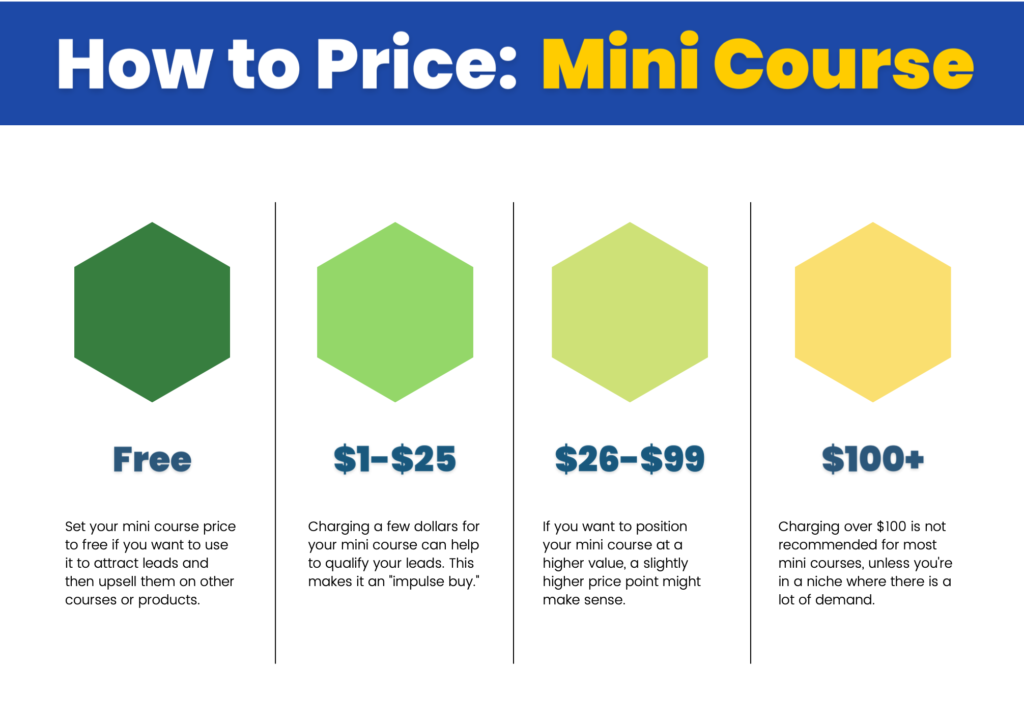Creating an online course always sounds easy enough when you’re just starting out. You have a skill or concept you want to share with the world — all you have to do is put together a few quick lessons to teach your students the basics, right?
But then flash-forward to six months later and you’re feeling totally burnt out as you hit record on “Module 6: Part 2: Video 13” of what you thought would be an easy production. Here’s actual footage of you wondering how things got so out of hand:

This often happens to first-time course creators because making a full-scale course can take up a mega-ton of your time. Between the content, formatting, design, marketing, and branding — there are a lot of moving pieces in the process that can bog you down. (Especially if you’re a perfectionist.) So is it any wonder why so many creators abandon their projects before they ever see the light of day?
Thankfully, there’s another type of online course that’s much easier, faster, and more cost-effective to produce. It’s called a mini course — and this snackable elearning alternative is growing massively in popularity for both creators and online students alike.
Here’s how online video coach and Thinkific expert XayLi Barclay describes it:
If you are just starting out on your online course journey, a mini course is an awesome way to test an idea with low time and money investments. One of my first mini courses developed into a larger course that we offer today!
But in order to create a best-selling mini course — you first gotta know how they work, how to position them effectively, and what elements you should (and absolutely should not) include in your mini course curriculum. That’s why we chatted with some of the top mini course experts to get their tips on how to create the ultimate mini course.
Keep reading or jump ahead to get step-by-step instructions and see real examples of mini courses in action…
What is a mini course?
A mini course is a short and snappy online course. The average mini course takes 90 minutes or less to complete and focuses on helping people learn one specific skill or concept. Creators often use mini courses as a tool to attract leads or for market validation.

Compared to a regular online course, mini courses tend to be much more focused, action-oriented, and, of course, quicker to complete. Justin DeMers, co-founder of Wake Up to Freedom and the Mini Workshop Magic, says you have to think about mini courses as being fundamentally different from a full-fledged online course:
It doesn’t work to just shove a full course into a smaller time frame or a smaller container. For a mini course, you have to think in terms of small promises. What is something that’s on someone’s to-do list that you can tackle? What can be done in 30 minutes or 60 minutes? Like, actually get done?
Most mini courses cost between $0 and $100, making them more affordable for students as well. Creators often use a free mini course as a stepping stone to get students interested in the rest of their content, so they can upsell them into longer and more expensive courses down the road.
Why go mini? 5 benefits of creating a mini course
If you’ve ever been in a grocery store, you know the appeal of buying something smaller than normal. Mini-cupcakes, mini-brownie bites, mini-burgers… There’s just something majorly appealing for customers when you put a big product in a small package. The same is true for online courses — here are some of the biggest benefits of creating a mini course.
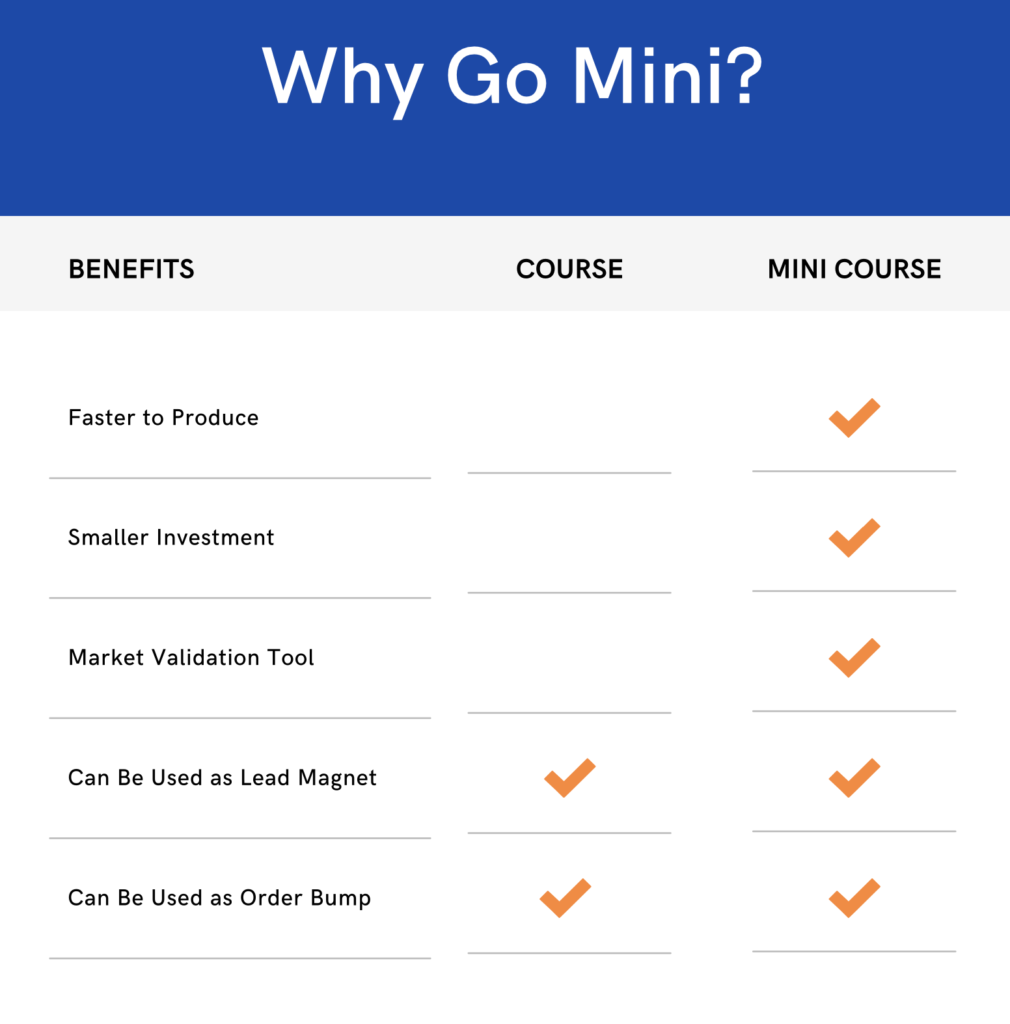
1. Mini courses are faster to produce
The most obvious benefit is that a mini course doesn’t take nearly as long to create. You can typically produce a mini course in under two weeks time, taking off a lot of the pressure creators usually feel when they’re producing a larger course. With less of a time investment, you’re free to have more fun with the content and worry less about sales.
This is something Sarah Temte, Co-Founder of Wake Up to Freedom, says is a huge benefit for first-time course creators:
You could actually have something launched, making money, and helping people two weeks from now. We’ve had so many people say, ‘I’ve had the course that I’ve been building for a year. But somehow I was able to launch this little workshop in just a few days.’ So I think it’s this huge win.
2. Mini courses validate your market
Mini courses also give you an opportunity to test the waters on any particular topic or niche that you’re interested in pursuing. Before spending weeks (or months!) investing your time and energy into “Nautical Flags: The Definitive Course” — you can put out a mini course in just a few hours to see if there’s an audience and an appetite for the learning you want to provide. (e.g. “Free Flag Etiquette Workshop”). Here’s XayLi Barclay again:
When you are starting out on your online course creation journey, it’s smart to pull out just a portion of that bigger online course idea and use that to start creating your mini-course. Be sure to ask your audience if they’re interested in what you’re creating before you start creating it.
3. Mini courses are easier to digest
On the student side of things, mini courses are great because — just like mini-burgers — they’re so much easier to digest. Rather than cover everything about a broad topic (e.g., “The Ultimate Course to Leadership”) you’re focusing on one specific problem that your audience has or skill they’re trying to learn (e.g., “How to Fire Someone Gracefully”).
Because, as Justin DeMers points out, most people don’t have the time to sit down with over 200 hours of video content on any given topic. They just want the most useful information distilled down as quick and easy as possible:
The idea of ‘more’ used to be a selling feature. You’d get 12 modules and 18 bonuses in a big purchase…But now? We’re all busy. I have two kids. I have a business to run. I don’t want more. I just want the stuff that matters.
4. Mini courses can sweeten your offer
If you’re thinking long-term and looking to scale your business up, mini courses are also a fantastic offering to have in your back pocket. You can use them as an add-on order bump or include them in a course bundle to provide extra value to your audience. (And increase your average order value, as XayLi Barclay points out below!)
You’re able to use [a mini course] later on as a bonus or an upsell which provides more opportunities to sweeten your offers. This can even come in handy as you grow and you start developing an online course suite.
3. Mini courses attract more leads
One of the biggest reasons creators love mini courses is that you can use them to attract more leads into your marketing funnel. A lot of folks might be interested in your $500 course on juggling — but do they really want to spend that much money on a new hobby they’re not even sure they’re going to like? Instead, you could offer a free or $15 mini course on “How to Juggle Two Balls in 20 Minutes.” This is what’s known as a brand extension, because you’re extending your brand’s appeal to a new set of potential customers.
Here’s Sarah Temte on the power of a low price point:
If someone can spend $20 or $50 and get a taste of something and get a result? That makes them way more likely to become a client, give you a great testimonial, and maybe buy one of your bigger offers in the future.
Related: 30 Effective Lead Magnet Ideas (With Examples)
7 steps to create a best-selling mini course
How do you go about actually creating a mini course? Hitting the sweet spot when it comes to the course topic, length, curriculum, and pricing is what separates a best-selling mini course from the duds. To start you off on the right foot, we chatted with expert mini course creators to get their tips and step-by-step strategies.
Choose a topic that’s super actionable
The first thing you need to hit on is the right topic for your mini course. Because while a full online course has the luxury of time to go into all-encompassing details, conceptual frameworks, and related topics of learning — mini courses should be much more to-the-point.
Related: 10 Steps to Creating a Wildly Successful Online Course
You can think about it like this: what is the smallest promise you can make to your audience that will help them improve their lives? Sarah Temte says that one of the biggest mistakes she sees creators making is trying to bite off too much with their mini courses.
The ultimate goal should be for your students to actually accomplish something in their lives to actually get something done. It’s not: ‘How can I teach everything I know after years of building this expertise?’ Instead, you should be thinking: ‘How can I help someone in an hour or two check something off their to-do list?
Hone in on a specific audience
Next, you’ll want to make sure the topic you choose aligns with an actual problem that one particular audience is trying to solve. Because while most creators want their online courses to be as broadly appealing as possible, mini courses often perform best when they speak directly to a niche audience.
So while you could create this course: “The Ultimate Guide to Getting Better Sleep.”
You’ll likely be more successful with this course: “Surviving Sleep Deprivation: A Mini Course for New Parents.”
Don’t be afraid to get specific! Your topic shouldn’t appeal to everyone everywhere all at once — because then you risk watering it down. Instead, your target audience should snap their fingers when they see the title and instantly know that this mini course is for them. XayLi Barclay says knowing your audience like this is the key to success.
[The topic] needs to be a mixture of what my target audience wants, what I’m truly passionate about, and my experience. When you’ve understood exactly what this is for you, you’re then able to create a mini course that solves a specific problem for your audience in a digestible way.
Make bite-sized course content
Once you’ve picked your mini course topic and honed in on your audience, the next step is to actually get started on your lesson plan and course content. Keep in mind that your audience has a limited attention span and are looking for the meat on the bone. Avoid all filler and keep your mini course focused on whatever is most actionable and useful.
You want students to feel like they’re getting lots of wins and building momentum quickly as they go through the course. That’s why it helps to minify the lessons that go into your mini course, so students feel like they’re moving through it much faster. (Woah. Mini-ception.) Here’s Sarah Temte with more on this advice:
None of the lessons should take more than 10 minutes. So it shouldn’t be 20 minute videos or these huge descriptions. Instead, can you do a two or three minute video and a really quick template or action item? The whole idea is how bite-sized can you make it?
Don’t spend too long on the creative process
As you start working on your course content, it’s important to not overthink it. This is a mini course after all — the whole idea is to move fast and get things done. The most important thing is to get it done and get it out there so you can see what your audience thinks. Sarah Temte says her main advice is to keep it simple:
Don’t make a mini course your life’s masterpiece. There’s no reason that launching a mini workshop or a mini course should take more than a week or two. So it doesn’t need to be the perfect branding, design, headlines, or marketing. That can all come later. For now — it can be really, really simple.
Price your mini course for impulse buyers
Once you have completed your mini course, you’re going to want to set the right price for it. Many creators opt to offer their mini courses for free, as a way to give leads a taste of what their full courses can offer.
That’s absolutely one approach you can take — but you may also want to consider setting a low price point, as well. Even charging students $1 will help to position your course as being more valuable (eg. worth paying for), and will help to filter out the tire kickers who are just looking for freebies and aren’t willing to pay. This is what Justin DeMers tells his students:
Nine out of 10 times, we recommend people use an impulse price point. Around the $20, $50, or $100 mark. Because we’ve all signed up for free courses with the best intentions… People who pay are more likely to do the work.
Market your mini course with momentum
Next, you’re going to need to make your sales page and start to market your mini course.
You can use a lot of the same strategies here that you would when marketing a regular online course. But one tip that is specific to mini courses? Focus on one new skill or ability that students will walk away with.
Because as Sarah Temte mentions below, it’s not really about what you’re going to teach them or what they’re going to learn — it’s about what they’re going to be able to do with your help.
It’s so easy to try to be in that conceptual zone. ‘I wanna give them all of this information, all of this theory, all of these helpful ideas.’ But we see over and over again that if you can help someone get a quick hack, a quick win, or build some quick momentum? That’s huge.
Iterate, experiment, and pivot
Finally, it’s time to launch! (Woohoo!) But hold your horses, partner — that doesn’t mean your work on the mini course is over. Because you put this out so quickly, there’s a good chance that there’s still room to improve on what you’ve already built.
Start collecting reviews and feedback from students on what they find useful about your mini course and what else they wish it covered. You can use their responses to iterate, experiment, and pivot with a new version of your mini course as Justin DeMers mentions below — or get ideas to create and sell another online course down the road. (Because hey, now that you’ve done it once. You know that you can do it again even better.)
You’re gonna put it out there and then you’re gonna say… ‘Hmm, okay. I think I could change this to help people get more results. Or I think I could remove this to help people get more results.’ It’s an iterative process.
3 mini course examples from Thinkific creators
Looking for some mini course inspiration to add to your mood board? Check out a couple of stellar mini course examples from real Thinkific customers.
1. The Learn Implement Share Academy

The Learn Implement Share Academy is an incredible resource for teachers looking to improve their teaching skills. They offer a variety of courses on topics ranging from “Empowering Your Mathematics Students” to “The #1 Course for Early-Career Teachers,” and typically cost anywhere between $200 – $800.
That’s why this mini course on “Teaching Equations Epically” is so great. Not only does it only cost $40, but it also makes it clear what action you will take away. It’s not just about becoming a better math teacher — it’s about how you can specifically teach equations in a way that students will love. And a peek at the tutorial contents shows you can complete the 20 lessons even faster than you can say BEDMAS.
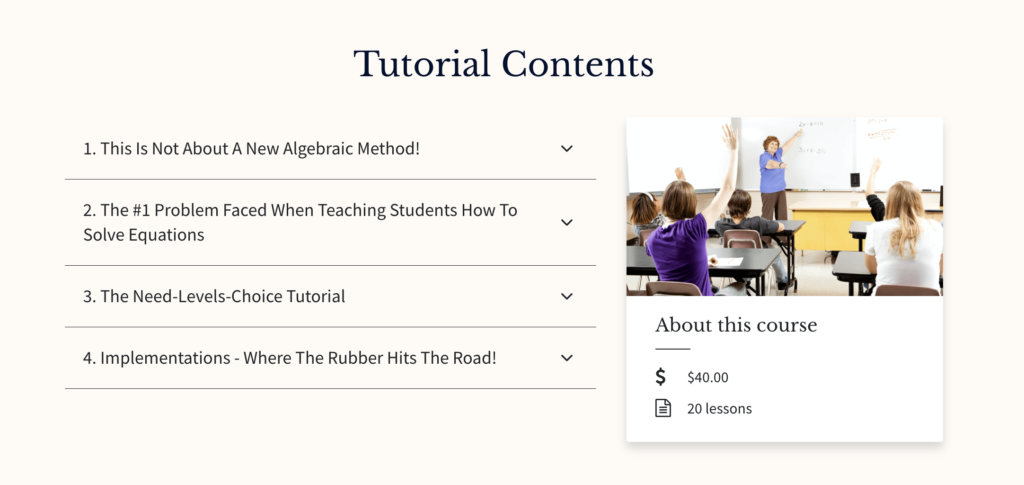
2. Start Shoot Grow Video Academy
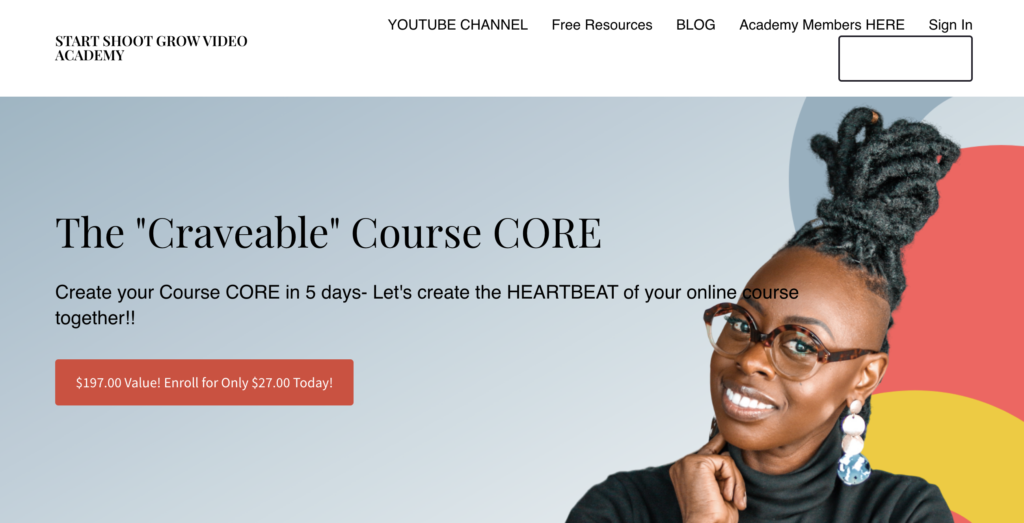
If anyone can create a great mini course, it’s Thinkific expert XayLi Barclay who runs the Start Shoot Grow Video Academy. Her “Craveable” Course CORE is the perfect example of how you can market a mini course with momentum. The promise of being about to create your course in five days is incredible, and the fact that it’s being offered at such a low price instantly grabs your attention.
And while most mini courses are designed to be completed in an hour or two, a closer look a the curriculum shows how doing a little bit of work each day across a week’s time makes much more sense in this case.
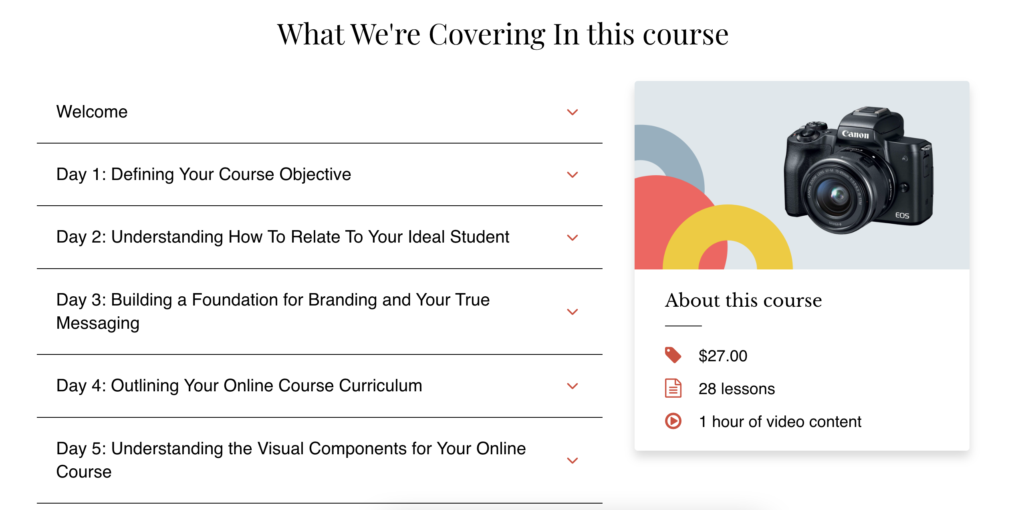
3. Start Shoot Grow Video Academy
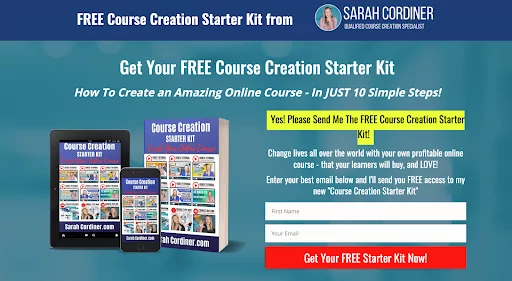
Sarah Cordiner runs the Edupreneur Academy, which offers dozens upon dozens of online courses on how to profit from your knowledge. A good number of these are mini courses and starter kits, which Sarah uses as lead gen magnets.
In a post on the Thinkific Studio for Online Course Creators Facebook community, Sarah says: “I usually offer them my most expensive offer, with a downsell to a cheap mini course if they don’t go for my main offer.”
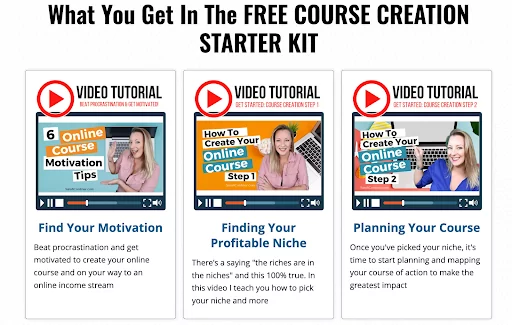
Remember: big things can come in mini packages
If you’re even somewhat curious about trying to create your own mini course, now is the best time to get started. The beautiful thing about them is that you don’t have to spend as much time planning and producing your course — you can get started today and be finished a few days from now. It’s low risk, with huge potential if you hit on the right topic.
Try Thinkific for free and get everything you need to create, market, and sell your mini course. No coding or tech skills required!
This guide was originally published in June 2022, and was updated in August 2023 with more information.


